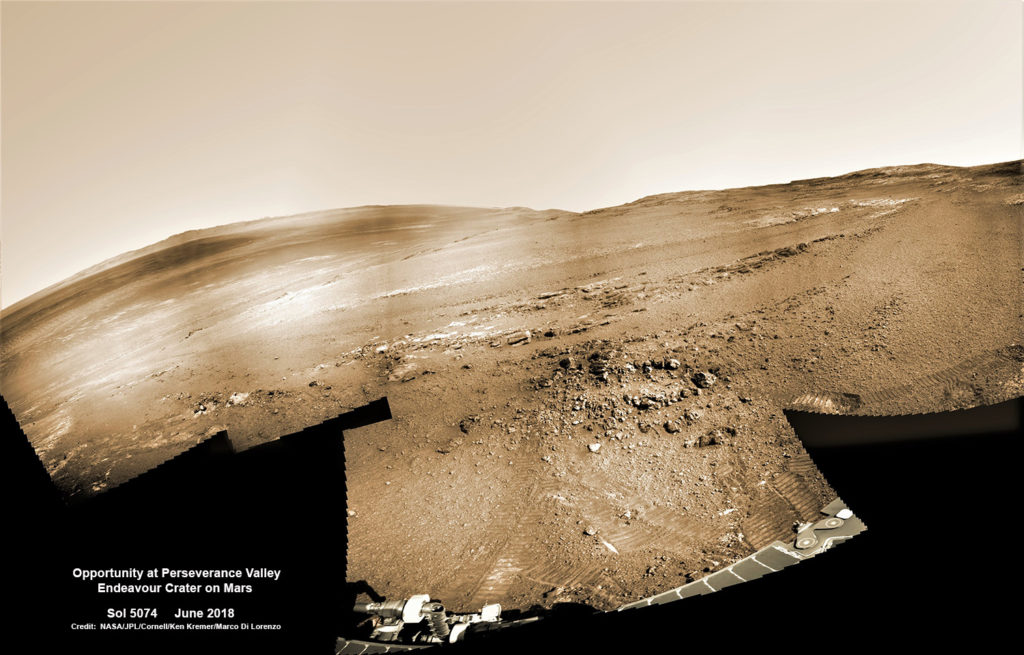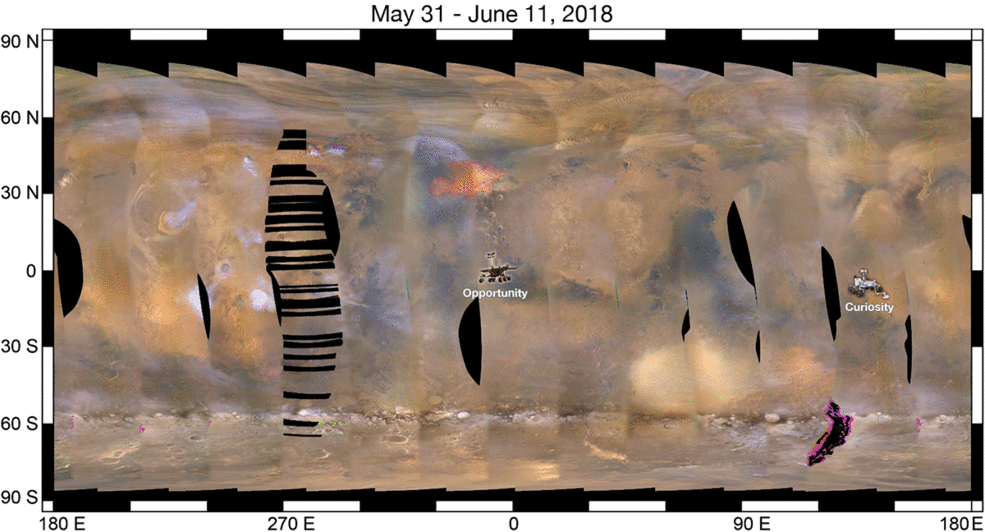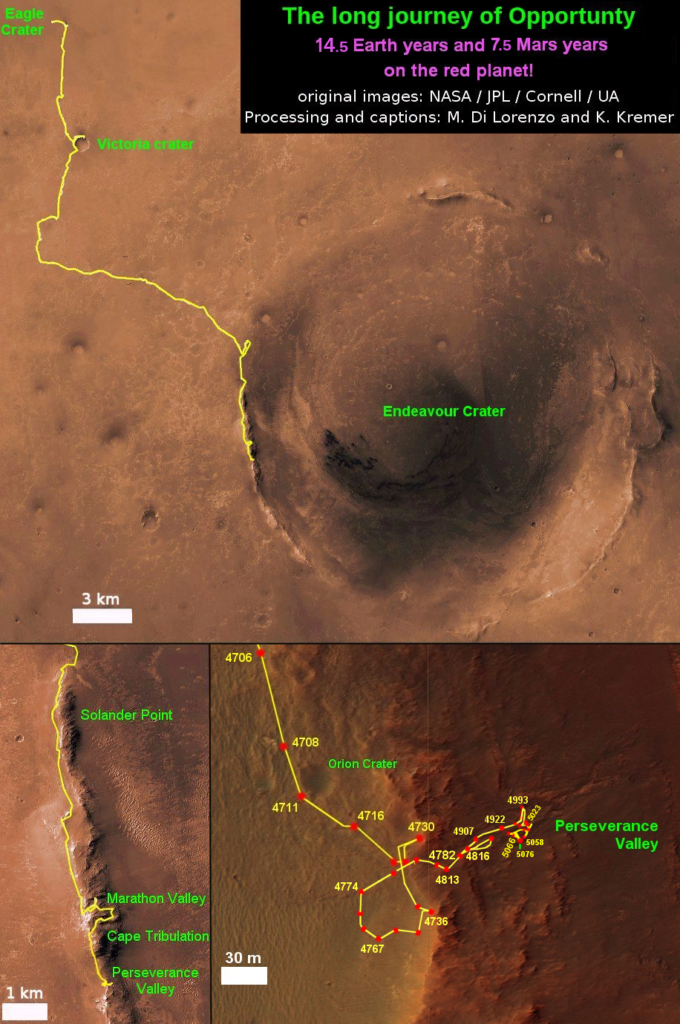Ken Kremer —SpaceUpClose.com &
RocketSTEM –25 January 2019
CAPE CANAVERAL,
FL – NASA’s world famous Opportunity Rover today marks 15 Years since a breathtaking
touchdown on Mars on Jan. 24, 2004 while conducting a resoundingly successful scientific foray on the alien
Red Planets surface on a stunning overland trek encompassing more than 28
miles (45 kilometers) across a region called Meridiani Planum.
Yet today, her
fate is unknown – having been silenced by a historic global dust storm that has cut off
all communications for over seven months with the celebrated but aged solar
powered rover.
Thus NASA announced
today that engineers are implementing a new strategy in hopes of making renewed
contact.
“The team is continuing to listen for the rover
over a broad range of times, frequencies and polarizations using the Deep Space
Network (DSN) Radio Science Receiver,” said NASA.
been sent!
strategy is urgently needed because the rover is heading into southern hemisphere winter
on Mars with decreased solar power generation possibilities and exiting the summertime
season that simultaneously helped cause the dust storm while offering the best hope
for generating solar power.
The six wheeled robot
has operated far beyond the wildest expectations of the science and engineering
team on a mission only warrantied to last a mere 90 sols, or 3 months since
sending her first
signal back to Earth from the surface on Jan. 24 at 9:05 p.m. PST (Jan. 25,
2004, at 12:05 a.m. EST).
Opportunity remains
“still silent” as of today, sadly.
The
last communication from Opportunity with Earth was received June 10, 2018 (Sol
5111).
“Fifteen years on the surface of Mars is
testament not only to a magnificent machine of exploration but the dedicated
and talented team behind it that has allowed us to expand our discovery space
of the Red Planet,” said John Callas, project manager for Opportunity at
NASA’s Jet Propulsion Laboratory in Pasadena, California, in a Jan. 24 statement.
“However, this anniversary cannot help
but be a little bittersweet as at present we don’t know the rover’s status. We
are doing everything in our power to communicate with Opportunity, but as time
goes on, the probability of a successful contact with the rover continues to
diminish.”
When the massive planet-encircling dust storm hit Opportunity had
been descending down and exploring Perseverance
Valley located along the eroded western rim of the gigantic 22-km diameter (14
mi) impact crater named Endeavour.
The global
Martian dust storm that gradually encircled the Red Planet started in late May
whipping up dust that blocked Opportunity’s solar arrays from generating power
and charging the life-giving batteries – thereby cutting off all communications
with Earth from the essentially dead robot.
Meanwhile the dust finally began to subside in
September when NASA began an active listening campaign initially scheduled to
last 45 days and known as ‘sweep and beep’.
NASA then extended the sweep and beep campaign while giving “top
priority’ to ensuring a successful touchdown for NASA new “InSight” over the
Thanksgiving 2018 holiday.
potentially favorable “windy
period on Mars — known to Opportunity’s team as “dust-clearing
season” — occurs in the November-to-January time frame and has helped
clean the rover’s panels in the past.”
unknown as is the amount of accumulated dust on the solar panels.
and multiple times per day – a process
known as ‘sweep and beep’ – hoping the six wheeled robot will wake up.
with Opportunity after “a planet-wide dust storm blanketed the solar-powered rover’s location on the
western rim of Perseverance Valley, eventually blocking out so much sunlight
that the rover could no longer charge its batteries. Although the storm
eventually abated and the skies over Perseverance cleared, the rover has not
communicated with Earth since then. However, Opportunity’s mission continues,
in a phase where mission engineers at JPL are sending commands to as well as
listening for signals from the rover. If engineers hear from the rover, they
could attempt a recovery,” according to NASA officials.
is changing on Mars and becoming potentially dire as wintertime encroaches on southern
hemisphere of the Red Planet where Opportunity is located.
and lower temperatures -both of which could kill off any chance for reviving Opportunity.
team,” the team said in a new statement released Jan. 25.
time of year on Mars when increased winds could clear the rover’s solar panels
of dust that might be preventing it from charging its batteries – is drawing to
a close. Meanwhile, Mars is heading into southern winter, which brings with it
extremely low temperatures that are likely to cause irreparable harm to an
unpowered rover’s batteries, internal wiring and/or computer systems.”
is can she rise from the dead like Lazarus and ‘phone home’ in the new few
weeks? Or is she permanently silenced?
Jet Propulsion Laboratory in Pasadena, California, have begun transmitting a
new set of commands to the Opportunity rover in an attempt to compel the 15-year-old Martian explorer to contact Earth. The new
commands, which will be beamed to the rover during the next several weeks,
address low-likelihood events that could have occurred aboard Opportunity,
preventing it from transmitting.”
continue active efforts to contact Opportunity for the foreseeable future,
until such time as they need or seek further guidance from NASA and JPL management.
lived Opportunity has survived or experienced over 5300 Sols (or Martian days)
roving the harsh environment of the Red Planet.
Opportunity has taken over
228,771 images and traversed over 28.06 miles (45.16 kilometers) – more than a marathon.
Watch for Ken’s continuing onsite coverage of NASA, SpaceX, ULA,
Boeing, Lockheed Martin, Orbital ATK and more space and mission reports direct
from the Kennedy Space Center, Cape Canaveral Air Force Station, Florida and
Wallops Flight Facility, Virginia.
Stay tuned here for Ken’s continuing Earth and Planetary science and human
spaceflight news: www.kenkremer.com
–www.spaceupclose.com – twitter @ken_kremer – email: ken at kenkremer.com
Dr. Kremer is a research scientist and journalist based in the
KSC area.
………….
Ken’s photos are for sale and he is available for lectures and outreach events
Ken’s
upcoming talks:
Apr 3: “Exploring
Mars; The Search for Life & A Journey in 3-D.” 7 PM, Lawton
C Johnson Middle School, Summit, NJ. Open
to the public. Details upcoming. Latest results from Mars & Ultima Thule
 |
| Ken Kremer/Space UpClose posing with full scale model of NASA’s Opportunity Mars Exploration Rover at Kennedy Space Center Visitor Complex, Florida |








